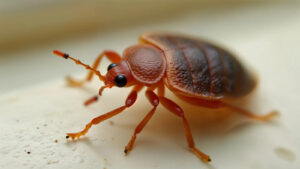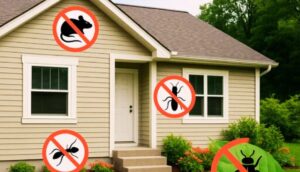How Do Bed Bugs Enter a House? Common Ways They Sneak In & How to Stop Them

Are you starting to wonder how bed bugs might be sneaking into your home? You’re definitely not the only one. These little hitchhikers have a sneaky way of getting in, and once they do, they can turn your peaceful nights into itchy, uncomfortable ones.
Bed bugs may be small, but they cause big problems if left unchecked. They don’t fly or jump, which makes it even more surprising how easily they find their way indoors. The truth is, they rely on us—our luggage, clothing, and even furniture—to catch a ride into our homes without us knowing.
Once they’re inside, bed bugs waste no time finding hiding spots close to where we sleep. Mattresses, cracks in the bed frame, and even behind baseboards become their cozy hideouts. If you’re not paying attention, a few bugs can turn into a full-blown infestation before you even realize what’s happening.
That’s why understanding how bed bugs get into your home is so important. It helps you prevent the problem before it starts—and prevention is always easier than treatment. With just a few smart habits, you can protect your home and sleep soundly at night.
In this article, we’ll cover the most common ways bed bugs get inside, signs that they might already be around, and practical tips to block them out for good. Let’s break it all down step by step so you can stay one step ahead of these pesky intruders.
As an Amazon Associate I earn from qualifying purchases
How Bed Bugs Get Inside Your Home
Bed bugs don’t fly. They don’t jump. Yet, they somehow still manage to invade homes all across the world. How?
The answer is simple: they hitchhike.
1. Luggage and Travel Bags
Hotels, airports, and public transportation are hotbeds for bed bugs. If you’ve recently traveled, your suitcase could have brought back some unwanted guests.
Tip: Always inspect hotel mattresses and furniture before unpacking. Store your bags off the floor and away from the bed.
2. Used Furniture
That secondhand couch might seem like a great find—but if it’s infested, it’s a nightmare waiting to happen. Bed bugs love hiding in seams, cushions, and cracks.
Tip: Avoid picking up furniture from the street. If you buy used items, inspect them thoroughly before bringing them inside.
3. Guests and Visitors
Friends or family might unknowingly carry bed bugs on their clothing or bags—especially if they’ve been staying in an infested place.
Tip: Encourage guests to leave shoes and bags at the door, and vacuum after visitors leave.
4. Laundry Rooms or Shared Spaces
In apartment buildings, dorms, or laundry facilities, bed bugs can transfer from one person’s clothes to another.
Tip: Use sealed plastic bags to carry laundry and avoid setting your clothes on public surfaces.
5. Public Transportation
Buses, trains, and rideshares are places where people—and their belongings—mix. Bed bugs can crawl onto your clothing or bags during a commute.
Tip: After long rides, inspect your clothing and bags when you get home.
6. Moving Trucks
Moving into a new home? Sometimes bed bugs come along for the ride in rental trucks or storage units.
Tip: Before loading items into a truck, inspect the space for signs of bugs or eggs.
7. Workplaces and Schools
Bed bugs are sneaky little travelers. They can hitch a ride on things like office chairs, school backpacks, or even employee lockers, and then quietly make their way back to your home with you.
Quick tip: Keep your belongings in sealed containers whenever possible and wash your clothes regularly to reduce the chances of bringing these pests inside.
Why Are Bed Bugs Such Expert Hiders?
These bugs are tiny, flat, and super quick, making it easy for them to squeeze into the smallest nooks. They can hide in the seams of your clothing, the edges of your phone case, or even inside books and electronics. Once inside, they look for cozy spots close to where you sleep—think mattresses, box springs, bed frames, and nightstands.
Spotting Bed Bugs Early Can Save You Trouble
Catching bed bugs early makes controlling them a lot easier. Watch out for these signs:

-
Small reddish or brownish stains on your sheets
-
Clusters or lines of itchy red bites on your skin
-
Tiny shed skins or eggs tucked around mattress seams
-
A faint, musty or sweet smell in the room
If you notice any of these, it’s time to act quickly.
Simple Ways to Keep Bed Bugs Out
The best defense is prevention. Here are easy habits to help keep your home bed bug-free:
-
Check your luggage after trips: Unpack and inspect your bags outside or in a garage, and wash your clothes in hot water as soon as you get home.
-
Be careful with secondhand stuff: Before bringing in used furniture or clothes, give them a close look with a flashlight—check all the folds, seams, and cracks.
-
Seal up small openings: Bed bugs can travel through tiny gaps in walls, especially in apartments. Seal cracks around baseboards, outlets, and plumbing to block their paths.
-
Use mattress covers: Special bed bug-proof covers for your mattress and box spring can keep these pests from settling in and make it easier to spot any problems early.
-
Keep clutter to a minimum: Bed bugs love hiding spots, so keeping your home tidy helps you spot any issues faster and leaves fewer places for them to hide.
❓ 10 Frequently Asked Questions (FAQs)
1. Can bed bugs come from outside?
Not usually. They prefer indoor environments where they’re close to a food source—you! But they can crawl in from infested apartments or items brought in from outdoors.
2. Can you bring bed bugs home without knowing?
Yes. Most people don’t realize they’re carrying bed bugs until bites appear or signs show up at home.
3. Do bed bugs only come from dirty homes?
No. Bed bugs don’t care if your home is spotless or messy. All they need is access to people and a place to hide.
4. Can bed bugs live in clothes?
Yes. They can hide in folds, seams, and pockets—especially in clothes stored close to sleeping areas.
5. Will washing clothes kill bed bugs?
Yes, but only if the water temperature reaches at least 120°F (49°C). The dryer is even more effective.
6. Do bed bugs travel on pets?
Rarely. They prefer humans but can hitch a ride on pet bedding or carriers.
7. How fast do bed bugs spread in a home?
Bed bugs reproduce quickly. A small infestation can turn big in just a few weeks if untreated.
8. Can I get bed bugs from a neighbor?
Yes, in shared housing like apartments. They can travel through walls, hallways, and electrical outlets.
9. How can I tell if a used couch has bed bugs?
Look for black spots, shed skins, tiny white eggs, or a musty odor. Check seams and underneath cushions.
10. Do bed bugs only come out at night?
Bed bugs are more active when it’s dark and quiet—which is usually when we’re asleep. But they’re surprisingly flexible. If you’re awake at night and asleep during the day, they’ll shift their schedule just to stay close to their next meal. Creepy, right?
Final Thoughts: Don’t Let Bed Bugs Sneak Into Your Space
You might be wondering how these tiny pests make their way inside. The answer? They ride in quietly—on your suitcase, your clothes, that great thrift store find, or even a guest’s backpack.
It’s not about how neat or messy your home is. What really matters is paying attention and knowing how they travel. A few quick habits—like checking your luggage after a trip or giving used furniture a solid once-over—can make a huge difference.
Catching them early is your best bet. If you spot the signs and take action right away, you’ll have a much easier time getting rid of them—and keeping your home peaceful and pest-free.
Need help choosing the right bed bug treatment?
Check out our guides to top-rated bed bug products by clicking the links above to stop an infestation before it starts.











